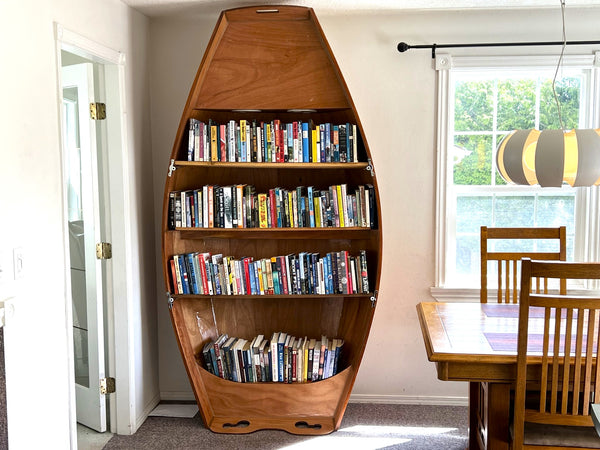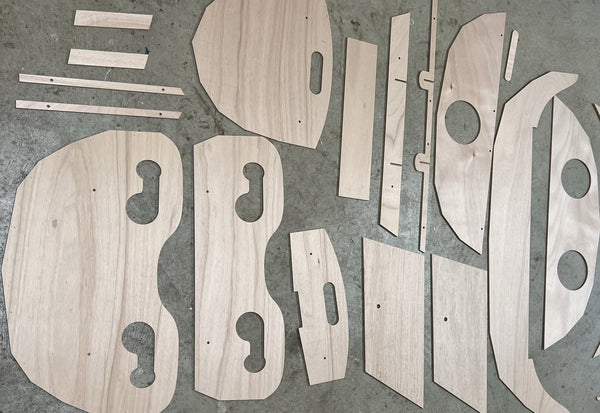Wooden Hollow Shaft Sculling Oar Plans Completed!
 There have been a few delays, but we’ve finally completed our comprehensive manual and plans for building exquisite hollow-shaft sculling oars. The plans are full-sized, laser printed on a ten foot long sheet, and the illustrated manual is very comprehensive.
There have been a few delays, but we’ve finally completed our comprehensive manual and plans for building exquisite hollow-shaft sculling oars. The plans are full-sized, laser printed on a ten foot long sheet, and the illustrated manual is very comprehensive.
Hollow shaft wooden sculling oars used to be a standard tool for competitive rowing. It wasn’t until the 1980s when Olympic rowers started switching to lighter synthetic substitutes. While carbon fiber oars are lighter than wood, the difference in weight is not as great as one might assume. A well-made wooden hollow-shaft sculling oar weighs about 4.5 lbs. (weight varies slightly depending on wood density and finish), while a carbon fiber oar of equivalent length is about 3.5 lbs. This difference in weight, while important in high-end competitive racing, is not such a big deal for performance recreational rowing. On the other hand, finely crafted wooden oars offer infinitely greater aesthetic appeal and significant savings. The cost of constructing your own oars will run from about $80-$200, a fraction of the cost of commercially built carbon-fiber oars.
The engineering behind our design is not new. The shaft is constructed to the same specs that have been developed by top engineers, and tried and tested for decades in the competitive racing world. We have, however, tweaked the blade shape and design to simplify construction as much as possible. Most importantly, we have spent months dissecting the construction process, distilling it into a simple step-by-step process that can be accomplished by first time oar builders.
While hollow shaft sculling oars used to be ubiquitous in the racing scene, now there are no manufacturers in North America producing them. There are a couple of specialized manufacturers in the UK producing wooden sculling oars, but with shipping a pair will cost north of $1500. So, if you’d like to own a pair of traditional sculling oars, an economical and enjoyable solution is to build them yourself.
Specialized tools such as spoke shaves, draw knives, and convex planes are not required to build these oars. Instead, the complex shaping can be achieved with just a standard hand plane, a half inch chisel, a utility knife, a hand saw and a flexible sanding block. A table saw is required for ripping long strips that the shaft is comprised from. Our step by step system using a series of templates ensures accurate and straightforward shaping.
For more information, please visit our oars page.
1 Response
powderpark
After reading several articles, I’ve also decided to make wooden hollow shaft oars for my new row-boat. Since the width of my row-boat is 120 cm (~ 4 feet) I think I should set the length of the oars roughly to 228 cm (~ 7.48 feet) according to the rule: Length of oars = 1.9 x distance between the oarlocks.
My question: If I use the plans, can it be possible to decrease the length of the oars to match the geometry of my boat? Will I have to sacrifice performance or rigidity if I change the length?
Leave a comment
Comments will be approved before showing up.
Also in News

Human Powered Achievements through the Northwest Passage
At Angus Rowboats, our passion for adventure naturally draws us to the mystique of the Northwest Passage – one of the world's most captivating and perilous waterways. Historically, this elusive passage promised a shorter shipping route, spurring early navigators to fervently chart and struggle through its icy intricacies.
The summer of 2023 saw three audacious teams, including one using our very own RowCruiser boats, aiming to be the first to traverse NW Passage solely by human power within a single season. As the season concludes, we've chronicled these attempts, and catalogued past human-powered endeavors to navigate the Northwest Passage.

Creating a Bookcase from a Boat


Angus Rowboats
Author